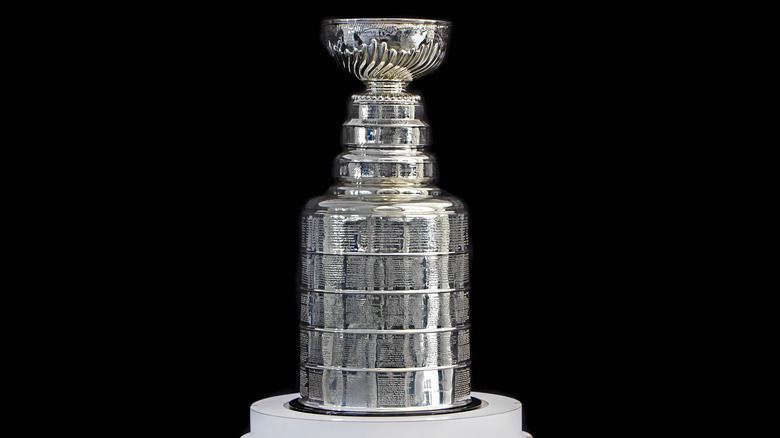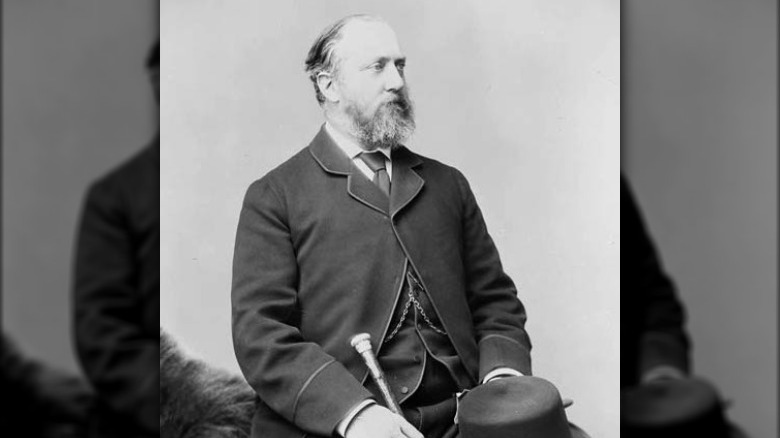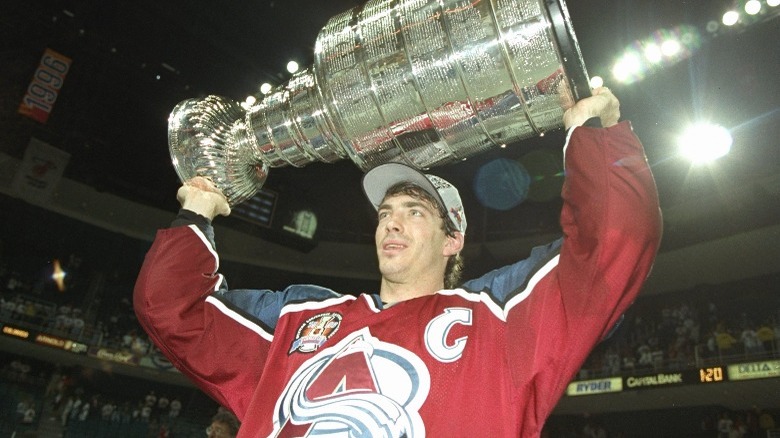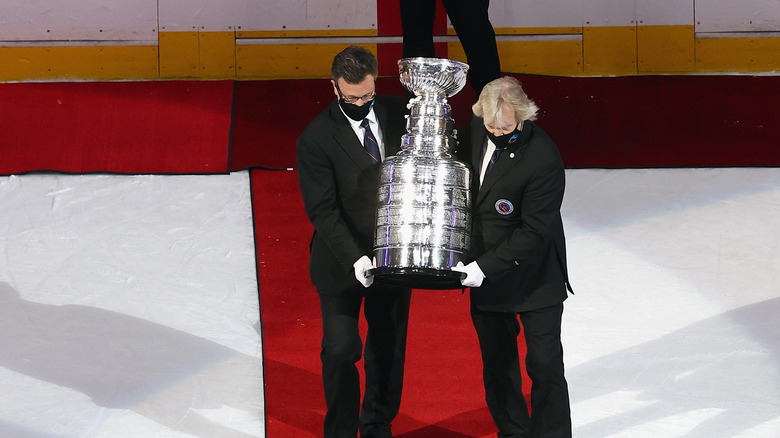The Real Reason The NHL Removes Champions From The Stanley Cup
There aren't many trophies out there that would make athletes willing to dive in front of small pieces of vulcanized rubber, have their teeth knocked out, and even go several months without shaving if that's what it takes to win it. The Stanley Cup is one of those trophies. Ask any hockey fan and they'll tell you that there is no better sight in sports than watching the players on their team — complete with Grizzly Adams beards, missing teeth, and black eyes — hoisting Lord Stanley's Cup.
The Stanley Cup is essentially hockey's holiest artifact and it's treated as such. It has its own handler, who is known as The Keeper of the Cup, per the NHL. That's the individual who is responsible for maintaining the Cup's immaculate appearance and wiping away any greasy fingerprint that comes anywhere near it.
Another great aspect of the Stanley Cup is that each team that wins has the names of their players and staff engraved on one of the Cups rings, where it will stay for good ... or at least until it's removed. Every 13 years, one of the Stanley Cup's rings is removed to make way for a new set of Champions (via the NHL).
The Stanley Cup was donated by Lord Stanley of Preston
According to the Hockey Hall of Fame, the Stanley Cup is North America's oldest professional sports trophy. It was donated by Sir Frederick Arthur Stanley. Stanley was born into the English aristocracy and eventually came to be the Governor General of Canada in 1888. In Canada, Lord Stanley was introduced to the sport of ice hockey and, according to The Canadian Encyclopedia, he was integral in developing the modern version of the game.
In 1892, Lord Stanley decided that the sport needed a proper challenge cup, as he referred to it, and donated a silver bowl that had the words "Dominion Hockey Challenge Cup" and "From Stanley of Preston" engraved on it. The Dominion Hockey Challenge Cup was intended to be awarded to the top team in Canada. Eventually, the somewhat wordy name of the Cup was changed to Stanley Cup, which rolls off the tongue much easier.
The National Hockey Association gained control of the Cup in 1910. According to History, the internal tensions between league owners led the NHA to fold, and a new league — the National Hockey League — was formed in 1917. Teams in other leagues competed for the Cup, including the 1917 champions, the Seattle Metropolitans of the old Pacific Coast Hockey Association. Starting in 1926, only NHL teams competed for the Cup.
The Stovepipe Cup becomes the modern Stanley Cup
According to ESPN, since it was first debuted in 1893, the Stanley Cup has been awarded every year since, with just two exceptions: 1919, when the series between the Seattle Metropolitans and Montreal Canadiens was canceled because of the Spanish Flu pandemic, and the other in 2005, after the 2004-05 season was completely canceled due to a lockout.
In the early years of the NHL's era of the Stanley Cup, a new ring was added to the Cup every year to honor each new winner. Each of these rings was skinny and the same size, which led the cup to take on an unusual appearance that earned it the nickname the Stovepipe Cup.
In the 1940s, the Stovepipe Cup was getting way too long and awkward for the winners to handle and lift above their heads in triumph, so the most famous trophy in sports underwent a redesign. The Stanley Cup took on its now-iconic shape. The idea of adding a new ring for every winning team was abandoned, and instead, the new design's larger rings featured blank spaces for multiple team names to be engraved around the Cup. According to the Hockey Hall of Fame, the Stanley Cup is the only trophy in pro sports where the name of each member of the winning team has their name engraved on the trophy itself. This is the era when the current Stanley Cup formula was born.
The process of retiring Cup rings
It was decided that each ring would feature a maximum of 13 teams, although for some reason that no one knows the answer to, the 1964-65 Montreal Canadiens occupy a space twice the size of a usual winner. Still, even with the modern version of the Stanley Cup, rings fill up. To maintain the Cup's height of 35.25 inches and its 34.5-pound weight, some rings needed to be retired (via Hockey Hall of Fame).
According to ESPN, this meant that after the 2005-06 NHL season, for the first time with this design, a ring of the Cup needed to be retired to make room for another. Following the Carolina Hurricanes' 2006 Cup victory, the ring featuring champions from the 1940-41 to 1952-53 seasons was removed. But where did it go?
The retired rings — which have traveled all over the world, as each player on the winning team gets a day to take the Stanley Cup wherever they want — are housed at the Hockey Hall of Fame in Toronto. Specifically, they sit in Lord Stanley's Vault in the Esso Great Hall. According to the NHL, the most recent retirement came in 2018 when a ring featuring the 1952-54 Detroit Red Wings to the 1964-65 Montreal Canadiens was removed to make room for a fresh ring. The first team on the newest addition to the Cup was the 2017-2018 Washington Capitals.



